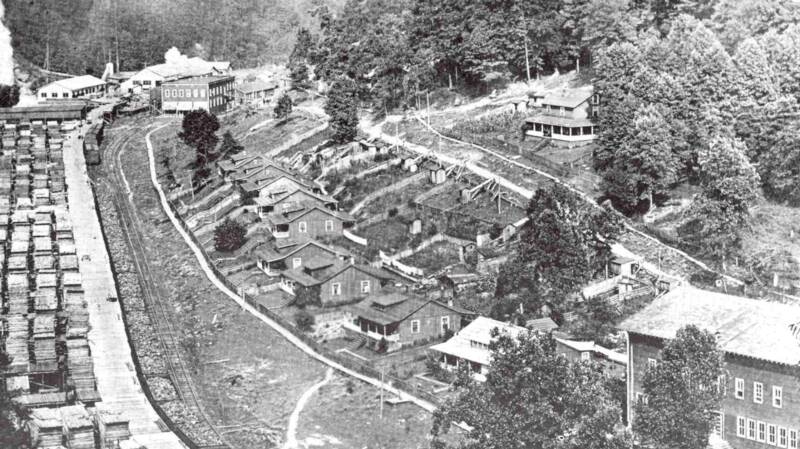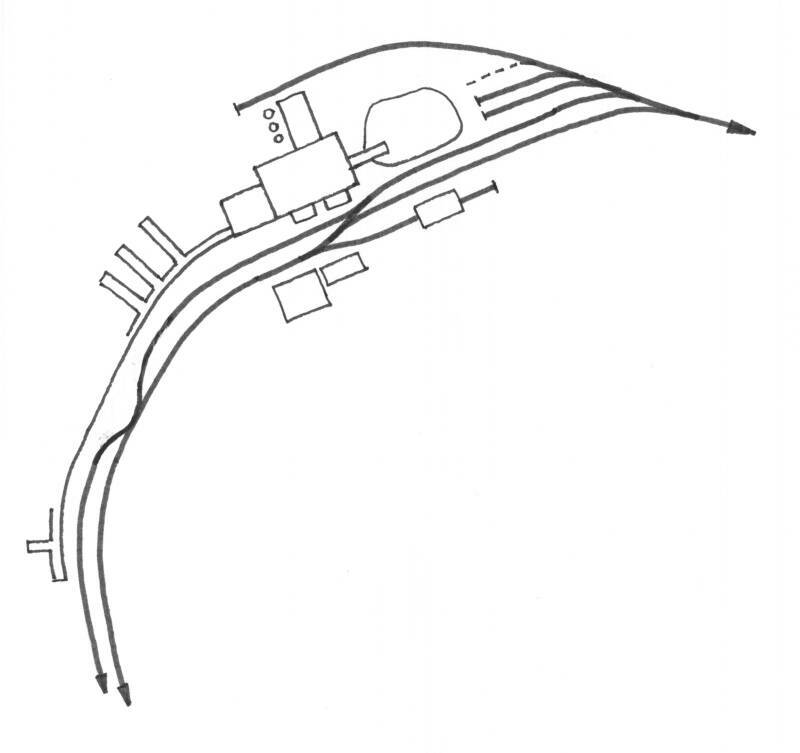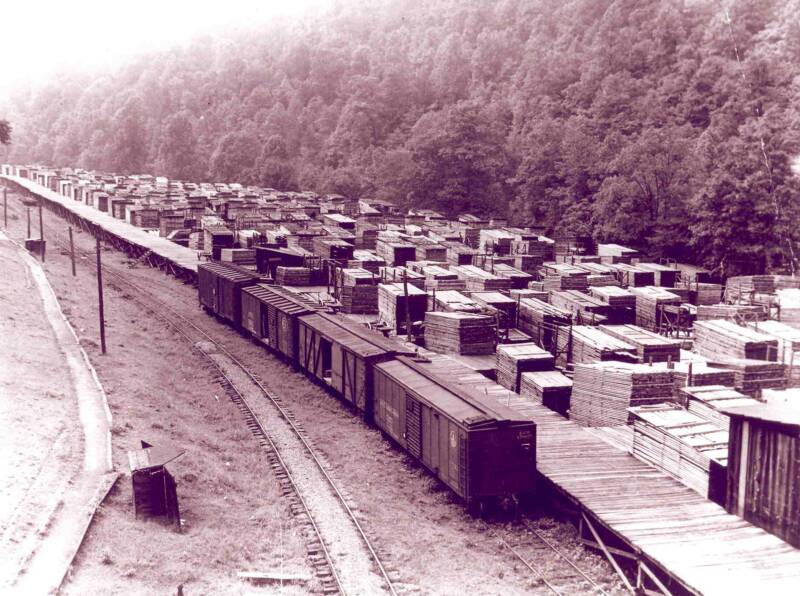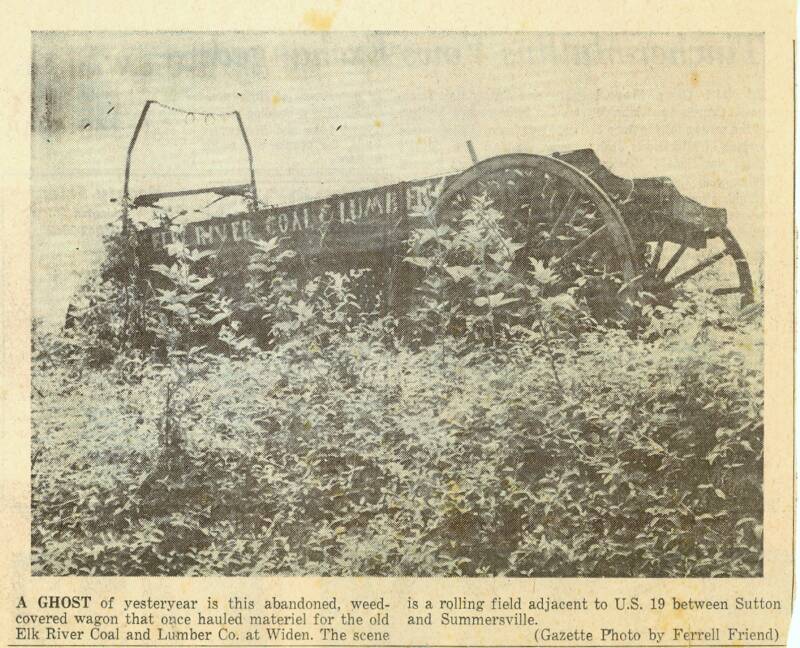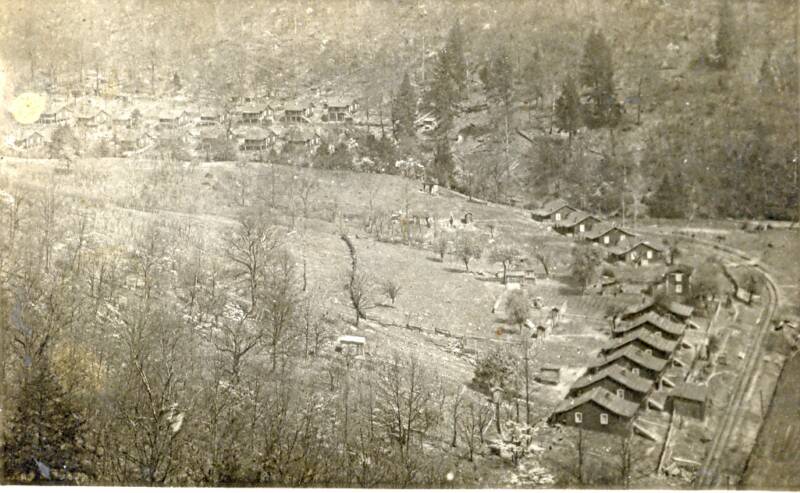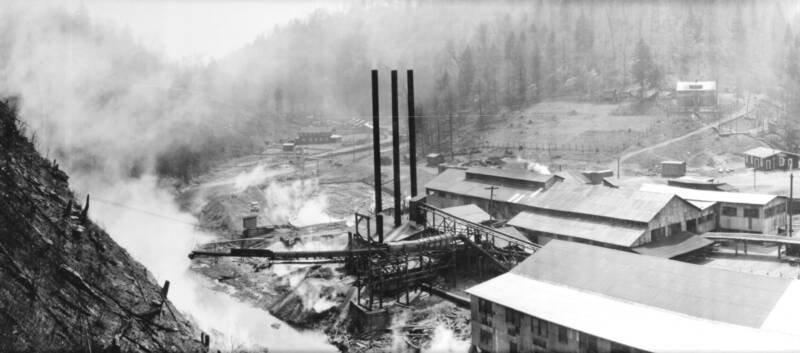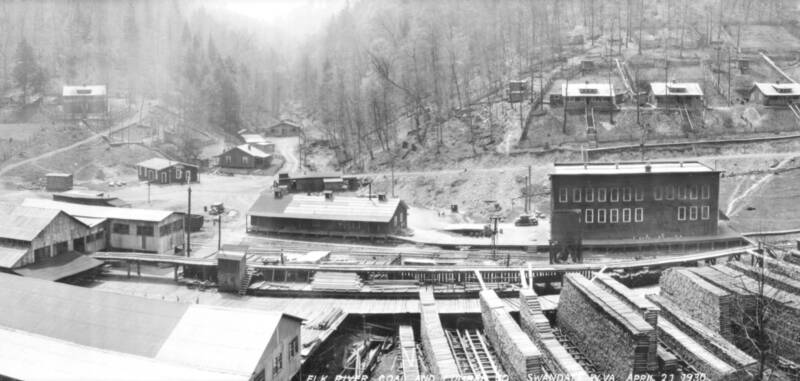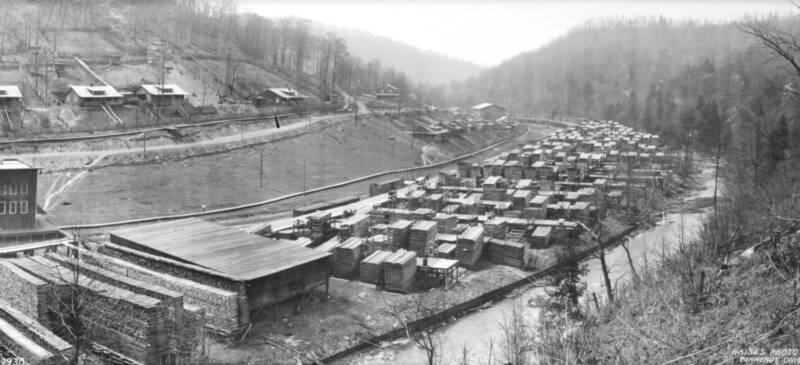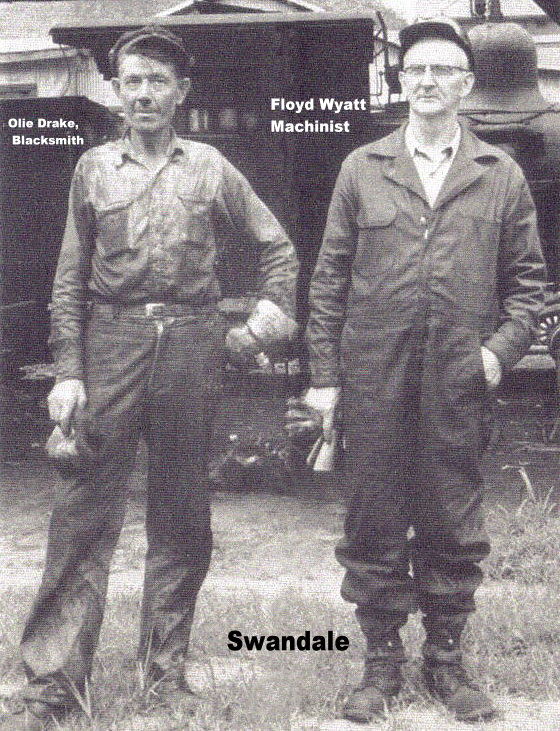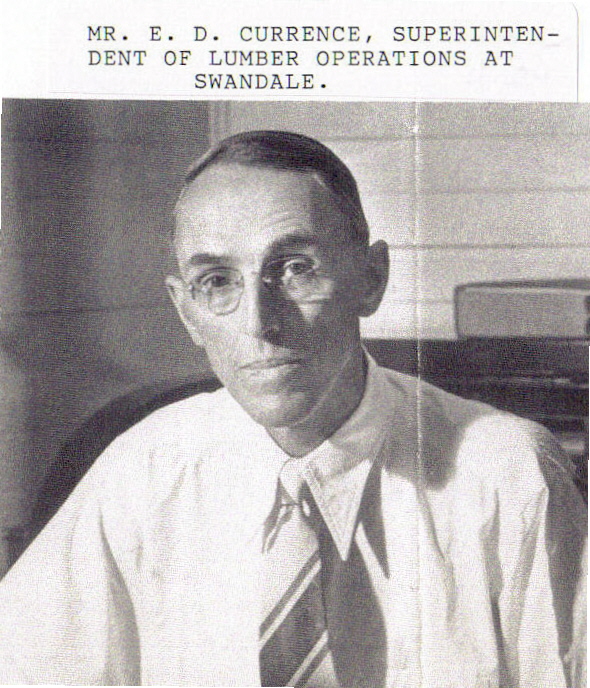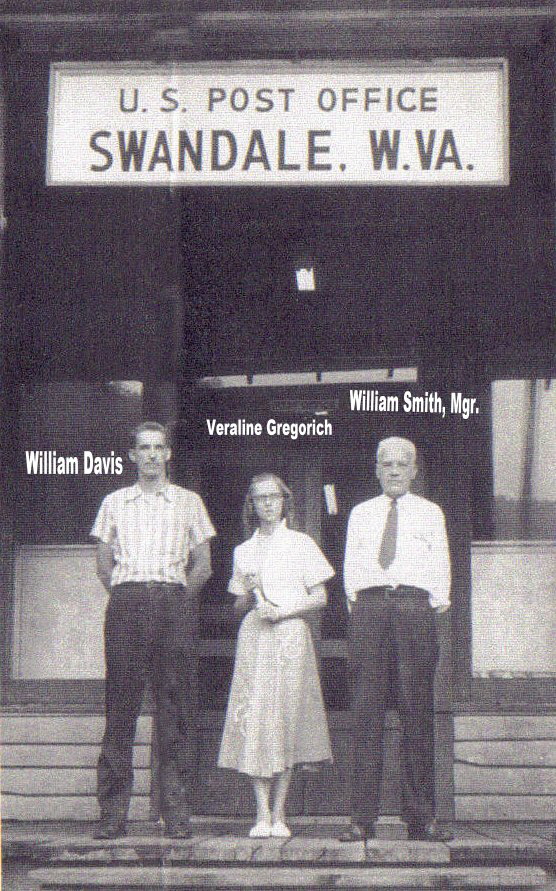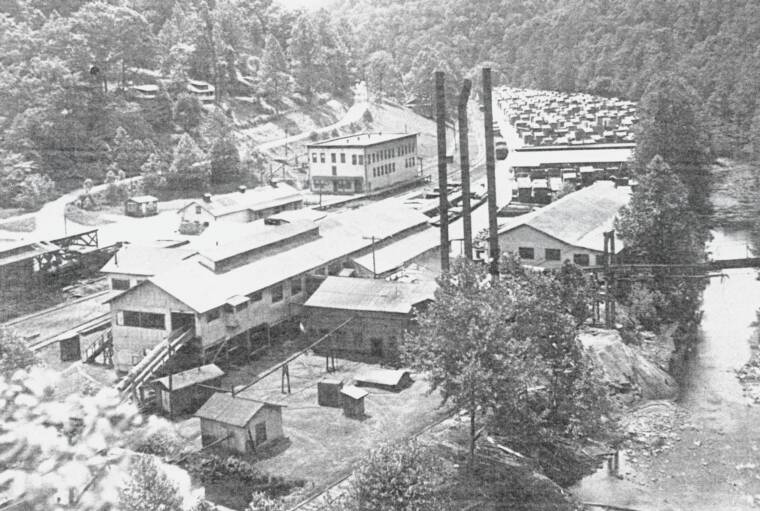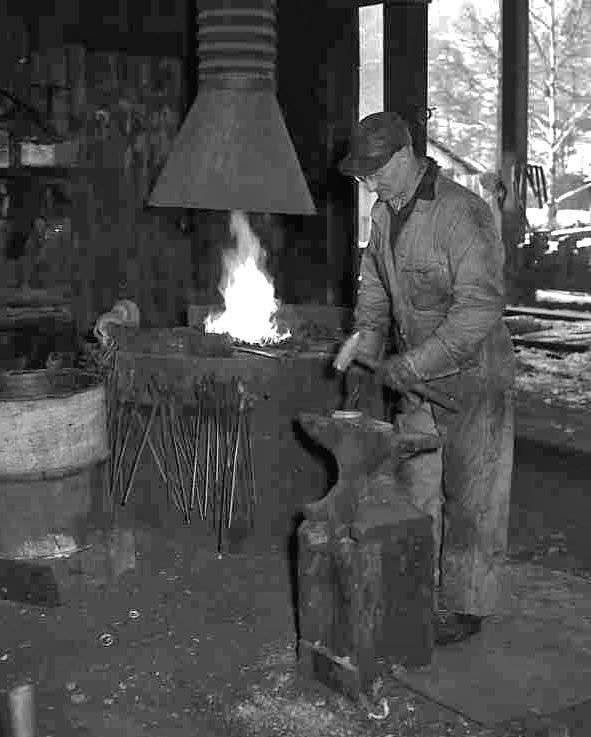SWANDALE
In this 1930's photo of Swandale, most of the town can be seen. The sawmill is in the upper left corner of this photo (1). The enormous piles of drying lumber stretched along the track (2). According to Kathy Gaskin's "Reflections on Swandale", at times there were as many as 5 million board feet of lumber in these piles representing a year's production. See also Frame's photo below.
Note the string of loaded hoppers on the siding (3).
Across the track from the mill was the company store, a large two-story frame building (4). In this photo is appears dark, perhaps "ERC&L Red". In subsequent years, it was light grey with green trim.
Numerous other buildings, including an engine house for the logging engines and company houses for workers, were also part of the scene. The home of the mill superintendent, E.D. Currence, is on the hillside (5). The Community Building is in the foreground (6). See also photo below.
Patsy Baughman points out that the small structures behind the homes that look like outhouses (7) were actually for the storage of coal for heating and cooking. Coal arrived via the narrow roadway, at one point in a horse-drawn wagon (see photo below), and was delivered to the sheds through the small chutes. Patsy recalls that the houses in this part of Swandale had indoor plumbing.
Cody Burdette says this photo was taken from the ballfield and that he "looked at this scene many times while playing on the field."
The population of Swandale in 1950 was 200 (West Virginia Logging Railroads, Warden).
In her Reflections, Kathy Gaskins recalls that there was no "motor road" to Swandale until 1930 and that the roads in Swandale were
never paved.
1
3
2
4
5
6
Track Plan Schematic - Circa 1950's
This track plan of Swandale was provided by Cody Burdette and redrawn by Brooks Stover.
Collection of Elvin Frame - circa 1930's
About 10 miles up the line from Dundon was the town of Swandale. It was here that the ERC&L Company located its sawmill. A good understanding of the history of Swandale comes from both Kathy Gaskin's "Reflections on Swandale", as well as a history of Swandale compiled by Elvin Frame. In 1910 the ELRC&L Co. let a two year contract to Charlie Deal to saw logs taken from the company property. He built a circular sawmill at the place where the Barren She joined the Buffalo Creek. In late 1913 a second circular mill was built near the first. Then in early 1914 ERC&L Co. started construction of a band sawmill near the second circular mill but construction was halted in late 1914 due to the start of WWI. Sometime around 1918 construction of the band sawmill resumed. The mill starting production on April 6, 1919 with the cutting of a large chestnut log.
The following excerpts about John Swan are from an unidentified biographical sketch provided by Elvin Frame:
"'Captain' John Swan, born in 1845 spent his early life in North Carolina where he learned the logging business and built several mills. He came to Clay County, WV in 1899 where he continued the study of growing forests and up-to-date logging practices. From the beginning, he appreciated the value of the oaks and poplars which grew in the eastern section of the county. He planned to convert them into a source of pertpetual wealth by wise cutting of the matured trees. He put an experimental operation at the mouth of Turkey Run on the south side of the Elk RIver six miles north of Dundon. He eventually built the mill on the Buffalo Creek where the Barren She comes in from the south. Captain Swan was the ERC&L Superintendent of Lumber and Timber Operations from 1903 through 1915/1916 and it was for him that Swandale got its name. Swan may have been one of the original nine shareholders of the ERC&L Co."
While the Rich Run Mine at Widen closed in December of 1963, the Georgia-Pacific continued to operate the sawmill after that. The BC&G hauled lumber from Swandale to Dundon until February 27, 1965. According the Warden's book, "after that the Plymouth diesel took over the job of hauling finished lumber to Dundon. But G-P saw the supply of merchantable timber dwindling and the cost of logging what remained growing constantly. In 1968. the logging operation in Clay County was terminated. By this time, trucks were hauling the lumber to Dundon for loading on the flat cars at the B&O interchange."
A
C
B
D
E
A
B
C
D
E
Hostler Track
Old Coal-Up Track
Coal-Up Track
Coal Car Track
Log Deck Track
BC&G Main
1
2
3
6
5
7
4
1 Sawmill
2 Planing Mill
3 Power House
4 Log Pond
5 Lumber Yard with 21 Wing Docks
6 Company Store
7 Feed House
8 Shops / Engine House
STRUCTURES
TRACK NAMES
F
F
Not to Scale
TO WIDEN
TO DUNDON
5
8
The crossover arrangement is shown here as it was in the 1930's. In the 1950's the lower crossover didn't exist (see photo above). Cody Burdette recalls that siding G held about 20 or 25 cars. See also Landis Jarvis description below.
G
7
Elvin Frame Collection
This previously unpublished photo from the collection of Elvin Frame gives a better idea of just how far the lumber piles reached. It looks like the piles and loading dock extend beyond the edge of the photo! The track as shown in the diagram above is visible in this photo. Notice the crossover (H) where the two sidings joing the main (J) and what looks like a small flatcar on the siding in the distance (K).
Patsy Baughman provided this wonderful snapshot from an undated newspaper of a wagon of the type used to deliver coal to homes in Swandale, and it's lettered for the Elk River Coal and Lumber Company. What a nice detail to model on a layout! For years the driver of this wagon was Marion Asbury who also delivered goods from the company store.
Patsy Baughman has provided this photo of 'lower' Swandale. The track from Dundon come into the photo from the bottom. The Community Building is out of sight to the left of the photo. This photo appears on a postcard that Patsy has in her collection.
Landis Jarvis points out that while it looks like the houses in the distance are two stories high, there are actually one story houses built on a step hillside. One man, Henry Lester, built two bedrooms under the house for some of his 21 children!
The boilers at the sawmill provided steam heat for some of the buildings in Swandale, specifically the Community Building (6) and the house of the mill superintendent E.D. Currence (5). The steam was transmitted to these buildings via an asbestos covered pipe that is visible in the photo above noted with arrow (8). Thanks to Patsy Baughman, Nelson Spencer and Phil Bonzon for sorting out the details about this pipe. According to Nelson, "the steam line was wrapped in asbestos and then strips wide enough to go around the pipe were cut from roll roofing which was 36" wide. They were overlapped and then tied on with wire and it made them waterproof. They held up very well..." Patsy recalls that as a school girl she and others actually walked along the pipe as they made their way to and from class. Notice that in the photo above the steam pipe runs just below wide path that in later years became a road. It was along this path that coal was delivered to the coal houses (7) behind the houses. Also visible in this photo is one of the several small sheds that housed fire hydrants located around Swandale (9) and the long boardwalk that stretched the length of the town.
Nelson further points out that "the first house (11) in the row below the company store was the doctor's house. This house and the one next to it are visible in the Elvin Frame photo here. The doctor's house also had steam heat.
8
9
11
10
Elvin Frame has graciously shared this spectacular panoramic view of Swandale taken on April 21, 1930 by the Haines Photo Company of Ohio. And thanks to Judy Gregorich Hart for getting it into digital format and to Phil Bonzon for getting it in a format for publication. On this website it is broken in to three parts (left, center and right) and each segment can be enlarged for better viewing by double clicking on the image. (NOTE: Once opened, the image can be further enlarged by holding down the "CTRL" key and turning the thumbwheel on your mouse.) The numbered arrows correspond to the arrows in the photo below, also taken in 1930.
1
4
2
6
Boarding House
Some People of Swandale
Three photos from the collection of Loretta Thompson Samples
Veralina Gregorich, shown here on the steps of the Swandale store, was the sister of Judy Gregorich Hart who has made significant contributions to this site and to the BC&G Cooperative and the Clay County Historical Society.
Horse Barn
The following recollections about Swandale were provided by Landis Jarvis, a long time resident of Swandale:
"There was a total of sixty two (62) houses in total in Swandale until over time three of them burned down...one up on the hill above the store, onedown behind the school house and one down in the lower end of town.
"Originally the main lumber dock went all the way down to the railroad bridge with thirty-two (32) wind docks extending all the way out to the creek bank. There were four pairs of steps leading up on to the dock. One at the very lowere end, one across from the school house, one at the dog house and one at the dry sheads across from the store porch.
"There was a switch on the side track beside the main dock with the railroad cars of coal (yellow arrow #3 above) down about where the drainage ditch went across under the tracks and the docks to the creek. Around 1948 or 1949, ELRICO tore down the lumber docks up to the lower end of the school play ground and took out the switch and side track up to the first house above the school house. They tried to load box cars there but the lumber dock was too high.
"There were three men killed due to the operations of the mill and logging. One man named Chum Gray was killed driving horses on the lumber docks. Another man named Key (I don't recall his first name) was killed dumping logs into the mill pond. The third man was Brooks Litton who was killed hooking tongs down by the railroad bridge at the lower end of town.
"The company store was broken into three times. A long time ago two guys broke in and they got caught and served time for it. When I was in the sixth or seventh grade two boys from the school did it and they got caught. They went to jail for a year. The third time no one was ever caught.
"In the early days of Swandale, high school kids rode the train to Dundon to attend school in Clay.
"Baseball was a big thing in the summer at Swandale. My Dad said for a long time Swandale had a very good team. Their ptichers name was Ed Gabert and they played a team from Charleston twenty three innings with no score. Because it was getting dark, the Charleston team let Swandale score one run so they could quit and go home.
"In the wintertime the community building got all the attention with school, school plays, Sunday school, church, and a revival or two, basketball, a movie on Tuesday night, cake walks, pie socials and other events. If the school needed money for some purpose or the other the teachers would put together some kind of event to raise money and everyone in town would pitch in and help. Schools today could take lessons from those people I think."
For much more information about the houses at Swandale click HERE
This overview of Swandale was taken in the mid-1950s according to Cody Burdette. His rationale is that in that time frame a major effort was undertaken to generally clean up the area around the sawmill. Notice how clean the ground around the mill is in the photo.
Another feature that helps date the photo is that the engine house (A) is still not enclused, an event that took place sometime in 1958 or later. One of the Shays can be seen sitting near the engine house.
The post office is clearly visible (B), and the company store (C) is in the lighter grey paint, not it's earlier red.
There appear to be rail cars spotted near the loading docks (D) and massive wood stacks but no people or automobiles are visible.
The photographer is not known.
A
B
C
D
H
J
K
Jim Dyson visited the BC&G in the early 1960s and captured this image of the blacksmith in Swandale. He recalls the man was working "in a building across the tracks from the sawmill". Enlarging the photo comfirms that the workpiece on the anvil is a horse. Jim had the pleasure of riding the log train that day!
Cody Burdette has identified the blacksmith in the photo as Tom Young, a longtime shop hand in Swandale.
